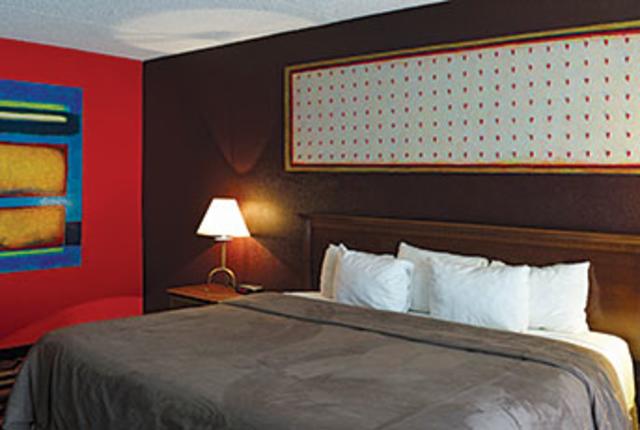Take a video tour of the Nativo Lodge's rooms. http://bit.ly/NativoLodge
Hotel guests are used to art in hotel rooms—that is, in a frame, likely chosen for its generic and blandly soothing properties. In four rooms of Albuquerque’s Nativo Lodge, however, art has taken over the walls from floor to ceiling—in the bedrooms, hallways, even the bathrooms. Frames hardly have a presence at all.
Nativo Lodge is one of Heritage Hotels’ boutique properties, which include Las Cruces’s Encanto and Santa Fe’s Hotel Chimayó. The group’s hotels telegraph prominent aspects of New Mexican culture, from the Spanish colonial and Mexican history of the Encanto to the artisanship of Hotel Chimayó’s namesake town (the hotel is furnished with the art and weavings of 70 Chimayosos). With the Nativo Artist Guest Room Project, Nativo Lodge (dedicated to Native culture) kicks it up a notch.
Guests accustomed to Nativo’s tasteful rooms will feel as if they’ve wandered into surreal dreamscapes, with familiar elements (Navajo rug-patterned carpet, luxe bedding, stately furnishings) contrasting with shimmering abstracts by Rhett Lynch, or the bold, public-art–informed murals of Ehren Kee Natay and Nanibah Chacon.
“I stayed in the Hotel des Arts, in San Francisco,” says Maresa Thompson, marketing and creative director for Heritage Hotels, referring to a boutique hotel with rooms individually devoted to the work of dozens of artists, including Shepard Fairey. “I chose the artist Jeremyville’s room, and it was such an intimate experience. Ever since then, I’ve followed the artist and become a collector of his work.”
Thompson saw this as a great idea for the Nativo, and last year the hotel consulted with the Southwestern Association for Indian Arts (SWAIA) to select four dramatically different artists whose installations would provide extraordinary guest experiences that reinforce an only-in-New-Mexico sense of place.
Rhett Lynch: Hózhó
Guests in Rhett Lynch’s room sleep below a wall painting, Prayers, adorned with 175 prayer ties Lynch has affixed to it. The red wall on their right, Spirit Window, an azure-background mural dominated by two plump, ochre rectangles, “asks the viewer to contemplate their own connection, to travel a little further beyond comfort, to remember we are all spirits,” explains Lynch (Diné), who lives in Alameda. Hózhó refers to the Diné concept of beauty and harmony. The colors in the room—mustard, eggplant, gold, red, and moss green—create an environment that’s both vibrant and soothing.
Lynch’s painting Grass Dance, an orange, blue, and red depiction of Taos Pueblo edged with multicolored fronds, was chosen for the cover of the book Contemporary Native American Artists, by Suzanne Deats and Kitty Leaken (Gibbs Smith, 2012). A giclée of this painting also hangs in the room.
You can meet Lynch and see more of his work at Indian Market, at booth 722 LIN-W. His website is rhettlynch.com.
Nanibah Chacon: Creation at Dawn
“When I think about large pieces, I want them to incorporate their surroundings,” says Nanibah Chacon (Diné, Chicana), who was born in Gallup. She looked down at the carpeting, which has a repeating chief’s blanket diamond motif in a palette of earth tones, and pulled the pattern and the browns and creams into a repeating theme painted on all of the walls. A riveting, oversize profile of the bust of Changing Woman, a depiction of the first woman in Diné cosmology, releases a bluebird into a chief’s blanket diamond shape. Together, the images represent creation. The bluebird signifies a new beginning, another fertility symbol.
“I’m very happy that people will get to interact with my art in a completely different way,” says Chacon. “It’s not like owning a piece of it, or seeing it for a few seconds in a gallery.”
Chacon won Second Place in painting at Indian Market in 2012. She is a resident artist at the Museum of Contemporary Native Art this August, and will debut a new body of work at Indian Market, in booth 772 LIN-E.
Ehren Kee Natay: KeeVa
In contemporary street artist Ehren Kee Natay’s (Diné, Kewa Pueblo) room, the bold, urban art visually explodes off the walls, from the sinuous, undulating Avanyu (the Tewa water-guardian deity) to Natay’s pop-art depiction of a Buffalo Dancer.
“I wanted to make cartoon characters that are really diverse,” says Natay. “All the time, you see cartoons of Native American people, reddish-brown people with feathers in their hair and exaggerated, caricature features. I’m trying to give another view on our culture and its place in pop culture.”
Natay will be showing at Indian Market, booth 766 LIN-W. His website is ehrenknatay.com.
Heidi K. Brandow: Question (material) Culture
Brandow (Native Hawaiian, Diné) attended the Institute of Indian Arts and Harvard, and taught architecture in Istanbul. Her background in industrial design is evident in a clean-lined room that wouldn’t look out of place in an IKEA showroom. The walls are cobalt, orange, and chartreuse, interspersed with sharp black-and-white lines and zigzags. Paintings of chair diagrams and cuddly-looking monsters punctuate the space.
“When I started selling my art 10 years ago, the monsters theme is one I worked with,” says Brandow, “so I wanted to include them as an homage to that earlier time.”
You can find her art for sale at the Santa Fe Artists’ Market, at The Range in Bernalillo, and at hkbstudio.com.
Need to know: Reserve an artist room by calling (505) 843-5300. See more at nativo-lodge.com.
Managing editor Candace Walsh is the author of Licking the Spoon: A Memoir of Food, Family, and Identity (Seal Press).


